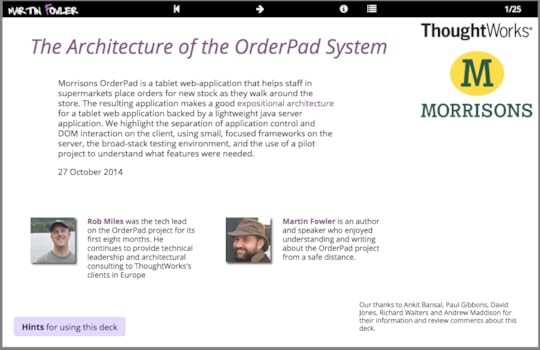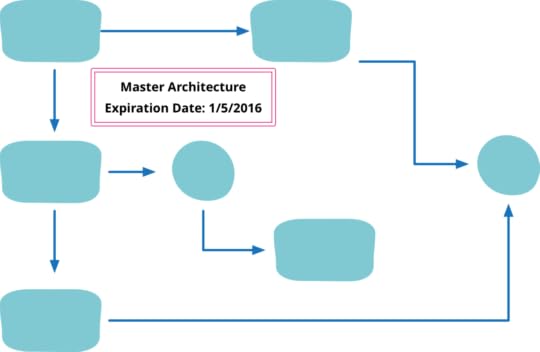Martin Fowler's Blog, page 37
November 19, 2014
Testing Strategies in a Microservice Architecture
Microservices has been quite the topic of conversation this year, with a rapid rise of interest. But although this architectural style is often a useful one it has its challenges, which can easily lead a less experienced team into trouble. Testing is a central part of this challenge, which is particularly relevant for those of us that consider testing to be a central part of effective software development.
My colleague Toby Clemson has responded to this question by distilling his experiences into an infodeck that explains the various testing techniques to use with microservices and when to use them. The first installment outlines the anatomy of a microservice architecture and explains the role of the first testing technique: unit testing.
Retreaded: TechnicalDebtQuadrant
Retread of post orginally made on 14 Oct 2009
There's been a few posts over the last couple of months about
TechnicalDebt that's raised the question of what kinds of design
flaws should or shouldn't be classified as Technical Debt.
A good example of this is Uncle Bob's post saying a
mess is not a debt. His argument is that messy code, produced by
people who are ignorant of good design practices, shouldn't be a
debt. Technical Debt should be reserved for cases when people have
made a considered decision to adopt a design strategy that isn't
sustainable in the longer term, but yields a short term benefit,
such as making a release. The point is that the debt yields value
sooner, but needs to be paid off as soon as possible.
To my mind, the question of whether a design flaw is or isn't
debt is the wrong question. Technical Debt is a metaphor, so the
real question is whether or not the debt metaphor is helpful about
thinking about how to deal with design problems, and how to
communicate that thinking. A particular benefit of the debt metaphor
is that it's very handy for communicating to non-technical people.
I think that the debt metaphor works well in both cases - the
difference is in nature of the debt. A mess is a reckless debt which
results in crippling interest payments or a long period of paying
down the principal. We have a few projects where we've taken over a
code base with a high debt and found the metaphor very useful in
discussing with client management how to deal with it.
The debt metaphor reminds us about the choices we can make with
design flaws. The prudent debt to reach a release may not be
worth paying down if the interest payments are sufficiently small -
such as if it were in a rarely touched part of the code-base.
So the useful distinction isn't between debt or non-debt, but
between prudent and reckless debt.
There's another interesting distinction in the example I just
outlined. Not just is there a difference between prudent and
reckless debt, there's also a difference between deliberate and
inadvertent debt. The prudent debt example is deliberate because the
team knows they are taking on a debt, and thus puts some thought as
to whether the payoff for an earlier release is greater than the
costs of paying it off. A team ignorant of design practices is
taking on its reckless debt without even realizing how much hock
it's getting into.
Reckless debt may not be inadvertent. A team may know about good
design practices, even be capable of practicing them, but decide to
go "quick and dirty" because they think they can't afford the time
required to write clean code. I agree with Uncle Bob that this is
usually a reckless debt, because people underestimate where the
DesignPayoffLine is. The whole point of good design and
clean code is to make you go faster - if it didn't people like Uncle
Bob, Kent Beck, and Ward Cunningham wouldn't be spending time
talking about it.
Dividing debt into reckless/prudent and deliberate/inadvertent
implies a quadrant, and I've only discussed three cells. So is there
such a thing as prudent-inadvertent debt? Although such a thing
sounds odd, I believe that it is - and it's not just common but
inevitable for teams that are excellent designers.
I was chatting with a colleague recently about a project he'd
just rolled off from. The project that delivered valuable software,
the client was happy, and the code was clean. But he wasn't happy
with the code. He felt the team had done a good job, but now they
realize what the design ought to have been.
I hear this all the time from the best developers. The point is
that while you're programming, you are learning. It's often the case
that it can take a year of programming on a project before you
understand what the best design approach should have been. Perhaps
one should plan projects to spend a year building a system that you
throw away and rebuild, as Fred Brooks suggested, but that's a
tricky plan to sell. Instead what you find is that the moment you
realize what the design should have been, you also realize that you
have an inadvertent debt. This is the kind of debt that Ward talked
about in his
video.
The decision of paying the interest versus paying down the
principal still applies, so the metaphor is still helpful for this
case. However a problem with using the debt metaphor for this is
that I can't conceive of a parallel with taking on a
prudent-inadvertent financial debt. As a result I would think it
would be difficult to explain to managers why this debt appeared. My
view is this kind of debt is inevitable and thus should be
expected. Even the best teams will have debt to deal with as a
project goes on - even more reason not to recklessly overload it
with crummy code.

reposted on 19 Nov 2014
November 17, 2014
photostream 77
November 4, 2014
Architecture of Morrisons OrderPad

Morrisons OrderPad is a tablet web-application that helps staff in supermarkets place orders for new stock as they walk around the store. My colleague Rob Miles and I felt that the resulting application makes a good expositional architecture for a tablet web application backed by a lightweight java server. We highlight the separation of application control and DOM interaction on the client, using small, focused frameworks on the server, the broad-stack testing environment, and the use of a pilot project to understand what features were needed.
Updates to Collection Pipelines

Over the last few weeks I’ve been quietly making a bunch of small updates to my article on collection pipelines. To the main text I’ve added a subsection contrasting them with Nested Operator Expressions. I’ve also added several operators to the operation catalog, including slice and various set operations.
October 26, 2014
photostream 76
October 22, 2014
Bliki: SacrificialArchitecture
You're sitting in a meeting, contemplating the code that your
team has been working on for the last couple of years. You've come
to the decision that the best thing you can do now is to throw away
all that code, and rebuild on a totally new architecture. How does that
make you feel about that doomed code, about the time you spent
working on it, about the decisions you made all that time ago?
For many people throwing away a code base is a sign of failure,
perhaps understandable given the inherent exploratory nature of
software development, but still failure.
But often the best code you can write now is code you'll discard in a
couple of years time.

Often we think of great code as long-lived software. I'm writing
this article in an editor which dates back to the 1980's. Much
thinking on software architecture is how to facilitate that kind of
longevity. Yet success can also be built on the top of code long since
sent to /dev/null.
Consider the story of eBay, one of the web's most successful large
businesses. It started as a set of perl scripts built over a weekend in
1995. In 1997 it was all torn down and replaced with a system
written in C++ on top of the windows tools of the time. Then in 2002
the application was rewritten again in Java. Were these early
versions an error because the were replaced? Hardly. Ebay is one of
the great successes of the web so far, but much of that success was
built on the discarded software of the 90's. Like many successful
websites, ebay has seen exponential growth - and exponential growth
isn't kind to architectural decisions. The right architecture to
support 1996-ebay isn't going to be the right architecture for
2006-ebay. The 1996 one won't handle 2006's load but the 2006
version is too complex to build, maintain, and evolve for
the needs of 1996.
Indeed this guideline can be baked into an organization's way of
working. At Google, the explicit rule is to design a
system for ten times its current needs, with the implication
that if the needs exceed an order of magnitude then it's often better
to throw away and replace from scratch [1]. It's common for
subsystems to be redesigned and thrown away every few years.
Indeed it's a common pattern to see people coming into a maturing
code base denigrating its lack of performance or scalability. But
often in the early period of a software system you're less sure of
what it really needs to do, so it's important to put more focus on
flexibility for changing features rather than performance or
availability. Later on you need to switch priorities as you get more
users, but getting too many users on an unperforment code base is
usually the better problem than its inverse. Jeff Atwood coined the
phrase "performance is a feature", which some people read as saying
the performance is always priority number 1. But any feature is
something you have to choose versus other features. That's not
saying you should ignore things like performance - software can get
sufficiently slow and unreliable to kill a business - but the team
has to make the difficult trade-offs with other needs. Often these
are more business decisions rather than technology ones.
So what does it mean to deliberately choose a sacrificial
architecture? Essentially it means accepting now that in a few years
time you'll (hopefully) need to throw away what you're currently building. This
can mean accepting limits to the cross-functional needs of what
you're putting together. It can mean thinking now about things that
can make it easier to replace when the time comes - software
designers rarely think about how to design their creation to support
its graceful replacement. It also means recognizing that software
that's thrown away in a relatively short time can still deliver
plenty of value.
Knowing your architecture is sacrificial doesn't mean abandoning
the internal quality of the software. Usually sacrificing internal
quality will bite you more rapidly than the replacement time, unless
you're already working on retiring the code base. Good modularity is
a vital part of a healthy code base, and modularity is usually a big
help when replacing a system. Indeed one of the best things to do
with an early version of a system is to explore what the best
modular structure should be so that you can build on that knowledge
for the replacement. While it can be reasonable to sacrifice an entire
system in its early days, as a system grows it's more effective to
sacrifice individual modules - which you can only do if you have
good module boundaries.
One thing that's easily missed when it comes to handling this
problem is accounting. Yes, really — we've run into situations where
people have been reluctant to replace a clearly unviable system
because of the way they were amortizing the codebase. This is more
likely to be an issue for big enterprises, but don't forget to check
it if you live in that world.
You can also apply this principle to features within an existing
system. If you're building a new feature it's often wise to make it
available to only a subset of your users, so you can get feedback on
whether it's a good idea. To do that you may initially build it in a
sacrificial way, so that you don't invest the full effort on a feature that
you find isn't worth full deployment.
Modular replaceability is a principal argument in favor of a
microservices architecture, but I'm wary to recommend that for a
sacrificial architecture. Microservices imply distribution and
asynchrony, which are both complexity boosters. I've already run
into a couple of projects that took the microservice path without
really needing to — seriously slowing down their feature pipeline as a
result. So a monolith is often a good sacrificial architecture,
with microservices introduced later to gradually pull it apart.
The team that writes the sacrificial architecture is the team
that decides it's time to sacrifice it. This is a different case to
a new team coming in, hating the existing code, and wanting to
rewrite it. It's easy to hate code you didn't write, without an
understanding of the context in which it was written. Knowingly
sacrificing your own code is a very different dynamic, and knowing
you going to be sacrificing the code you're about to write is a
useful variant on that.
Acknowledgements
Conversations with Randy Shoup encouraged and helped me
formulate this post, in particular describing the history of eBay
(and some similar stories from Google). Jonny Leroy pointed out
the accounting issue. Keif Morris, Jason Yip, Mahendra Kariya,
Jessica Kerr, Rahul Jain, Andrew Kiellor, Fabio Pereira, Pramod
Sadalage, Jen Smith, Charles Haynes, Scott Robinson and Paul
Hammant provided useful comments.
Notes
1:
As Jeff Dean puts it "design for ~10X growth, but plan to
rewrite before ~100X"
Talking about Refactoring on the Ruby Rogues Podcast

Last week I sat with the Ruby Rogues - a podcast about development in the Ruby and Rails world (Avdi Grimm, Jessica Kerr and host Charles Max Wood). They have a regular book club, and their book this time was the Ruby edition of Refactoring We talked about the definition of refactoring, why we find we don’t use debuggers much, what might be done to modernize the book, the role of refactoring tools, whether comments can be used for good, the trade-off between refactoring and rewriting, modularity and microservices, and how the software industry has changed over the last twenty years.
October 11, 2014
photostream 75
October 9, 2014
Keynote from goto: Our Responsibility to Defeat Mass Surveillance

In our keynote for goto 2014, Erik and I consider our responsibilities as software professionals towards combatting the growing tide of mass surveillance. We talk about how software professionals should take a greater role in deciding what software to build, which requires us to have a greater knowledge of the domain and responsibility towards our users and the greater society. We say why privacy is important, both as a human need and for the maintenance of a democratic society. We use the example of email to explore the importance of an open, collaborative development approach for key infrastructure, and argue our freedoms require a greater level of encryption for all of us together with move to decentralize. We finish with a brief mention of “Pixelated”, a project ThoughtWorks is doing to increase the use of encrypted email and why its challenges are much more about UX than the details of cryptography.
Martin Fowler's Blog
- Martin Fowler's profile
- 1103 followers









